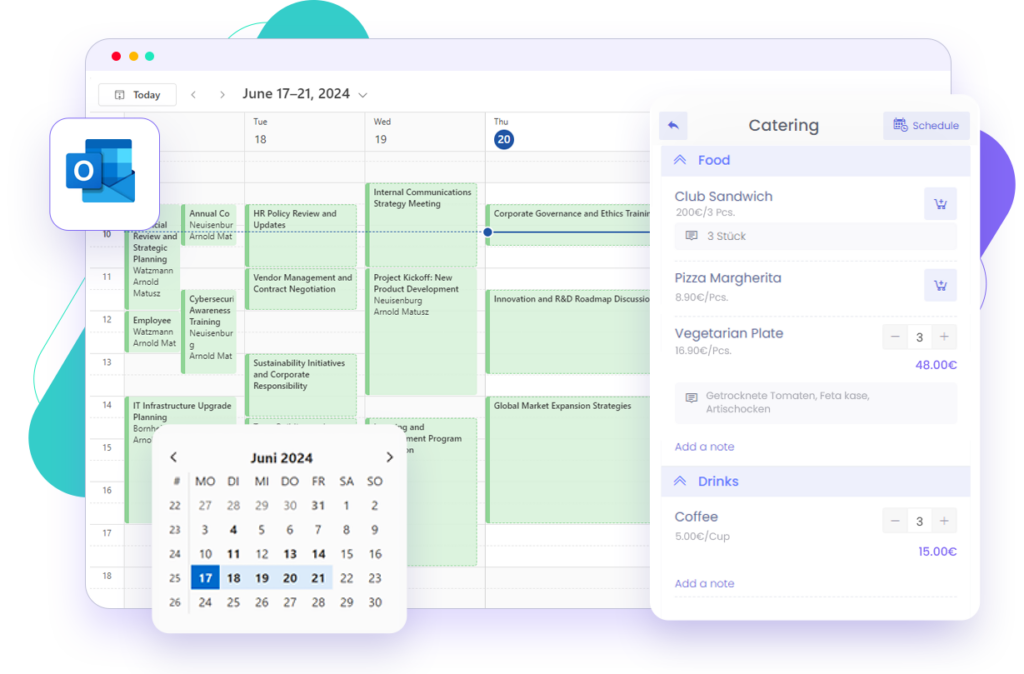Organising seating for meetings as a facility manager für
Organise seating for meetings like a pro
How facility managers can smoothly organise seating for meetings
Organising meetings involves much more than just reserving a room. Seating arrangements play a particularly important role, as they have a significant impact on the atmosphere and flow of a meeting. Whether it’s row seating for large presentations, U-shaped seating for workshops or a relaxed lounge arrangement for creative meetings, each option requires preparation, coordination and often changes by facility management.
Facility managers must ensure that all requirements are coordinated with the available room capacities. This becomes particularly challenging when short-term changes occur or additional services such as technology or catering need to be taken into account. Without a clear structure, this can lead to misunderstandings, a high workload and inappropriate use of the premises.
The biggest challenges in organizing seating arrangements
Communication and coordination between different departments
Seating adjustments are often communicated to the facility team by email or phone. This often happens at short notice, which causes stress and increases the likelihood of errors. The cooperation between meeting organizers and facility teams is not clearly defined in many companies. As a result, important information is lost or does not arrive in time.
Without a reliable structure, the facility team cannot ensure that all meetings are prepared as desired. The only option is to react spontaneously, which leads to delays and can affect the flow of meetings.
Lack of transparency regarding room capacities and seating options
Not every room is suitable for every type of seating arrangement. While some conference rooms can be rearranged flexibly, others have restrictions in terms of space and equipment. Often, this information is not stored centrally, so meeting organizers and facility managers first have to laboriously check whether the desired arrangement is even possible.
When this transparency is missing, rooms cannot be used efficiently. A large meeting room may be blocked for a small group, while a more suitable room would have been available. At the same time, rooms with fixed seating may be booked without this being taken into account during planning.
Short-term changes and additional requirements
Meetings often change at short notice. A meeting originally planned for ten participants can suddenly increase to twenty people. These adjustments require flexible seating, but in many companies there is no clear process for how such changes are handled.
In addition to seating, additional requirements also play a role. A larger group may need more presentation equipment, additional whiteboards, or a different table arrangement. Catering also needs to be adjusted, which can lead to problems without direct coordination with the responsible teams.
How facility managers can manage meeting seating smoothly
To implement seating changes without delays or misunderstandings, planning should take place in a structured manner. This reduces potential errors, saves time, and makes spontaneous adjustments easier.
Central recording of seating requirements
The required seating arrangement should already be specified when booking the room. A digital booking solution can directly record this information and display which seating options are available for the selected room.
Such a solution provides the facility team with all relevant information in advance, allowing them to prepare accordingly. At the same time, organizers can be confident that their desired configuration is feasible without having to check it separately.
Automatic forwarding to the facility team
Instead of managing seating requests manually via email or phone, all requirements should be forwarded directly to facility management. A central platform allows seating requests to be captured in real time and sent to the responsible teams.
If short-term changes occur, they can be updated directly in the system. This eliminates manual coordination and provides a clear overview of all requirements.
Adjustments for short-term changes
Meetings often change at short notice, requiring quick responses. A digital platform makes it possible to enter changes directly and inform the facility team in real time.
This eliminates manual communication effort and reduces the risk of misunderstandings or incorrect setups. At the same time, it ensures that all requirements are up to date and that transparent documentation is maintained.
How arbooMEET simplifies seating organization
With arbooMEET, organizing seating for meetings becomes much easier and more transparent. Instead of relying on manual coordination or unstructured processes, all requirements can be defined directly within Microsoft Outlook room booking.
Meeting organizers can select the required seating arrangement during the booking process. The platform automatically ensures that only seating options suitable for the chosen room are displayed. This eliminates the need for manual checks and reduces the risk of booking errors.
Once a booking is made, the facility team is automatically notified. All relevant information — such as seating type, number of participants, and any additional requests — is clearly transmitted without delay. If changes occur, they can be made directly within the platform. The system immediately updates the booking and informs the facility team of the adjustments, ensuring there are no misunderstandings.
In addition to seating organization, arbooMEET also makes it easy to manage additional services. If certain seating configurations require technical equipment such as projectors, microphones, or extra tables, these can be added directly during the booking process. Catering requests can also be included in the same step, eliminating the need for separate coordination.
This clear and structured management ensures that meetings are prepared without unnecessary delays. The facility team can focus on their tasks without constantly responding to last-minute requests or miscommunications. At the same time, meeting organizers can be confident that their requirements are accurately captured and implemented.
With arbooMEET, the entire seating organization process becomes more transparent, reliable, and easier to manage. Companies benefit from seamless communication between all teams involved and more efficient use of available resources.
Would you like to simplify your meeting organization? Request a live demo of arbooMEET and experience how easy managing seating requirements can be.

Related Content
Meeting Room Booking as It Should Be, Straight from Microsoft Outlook


